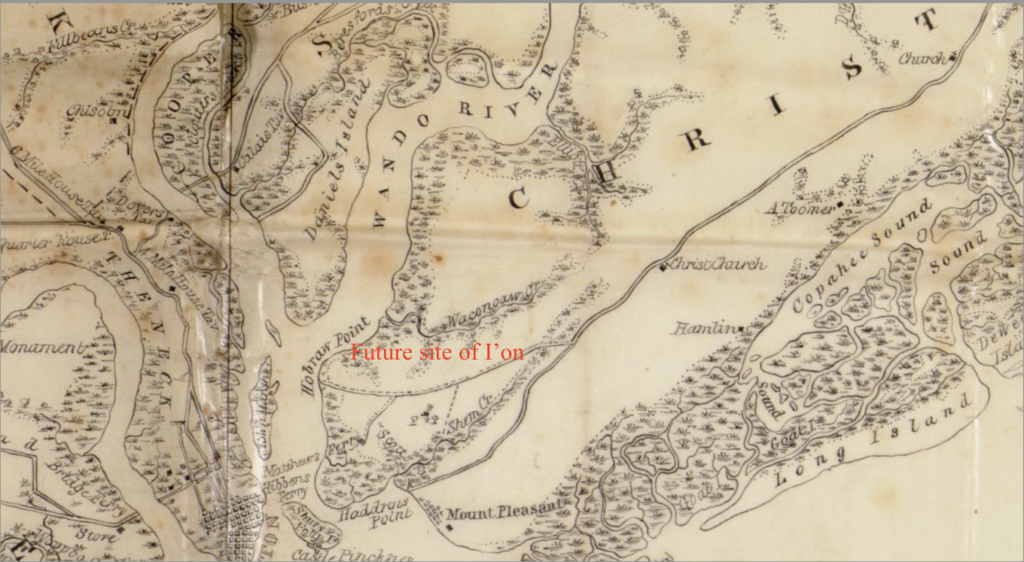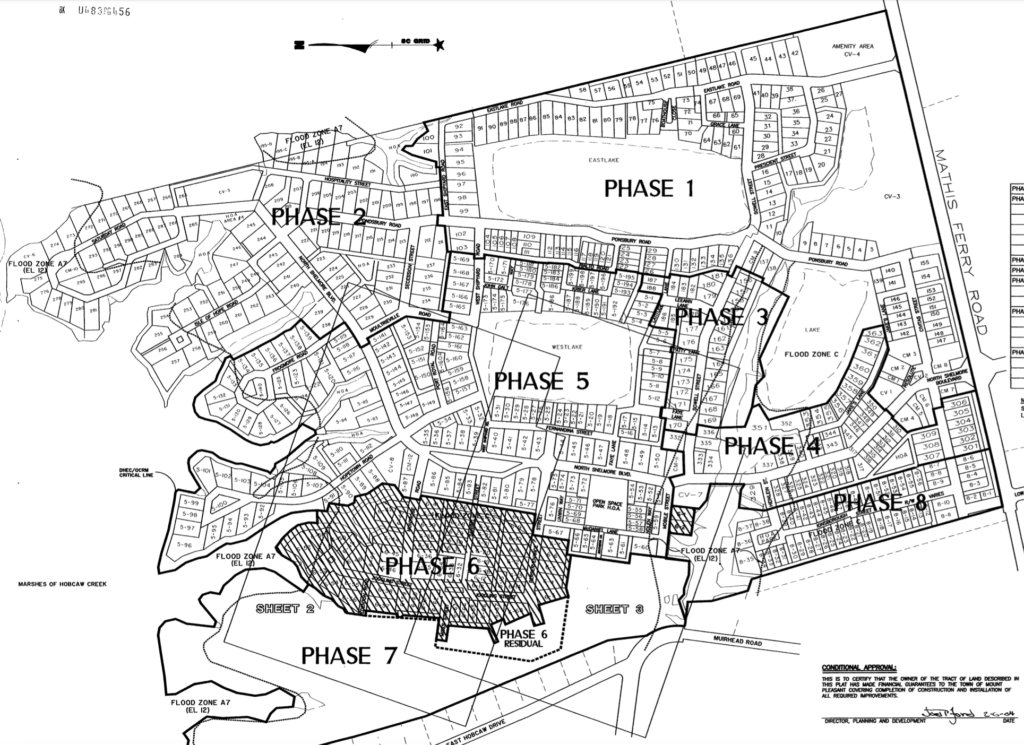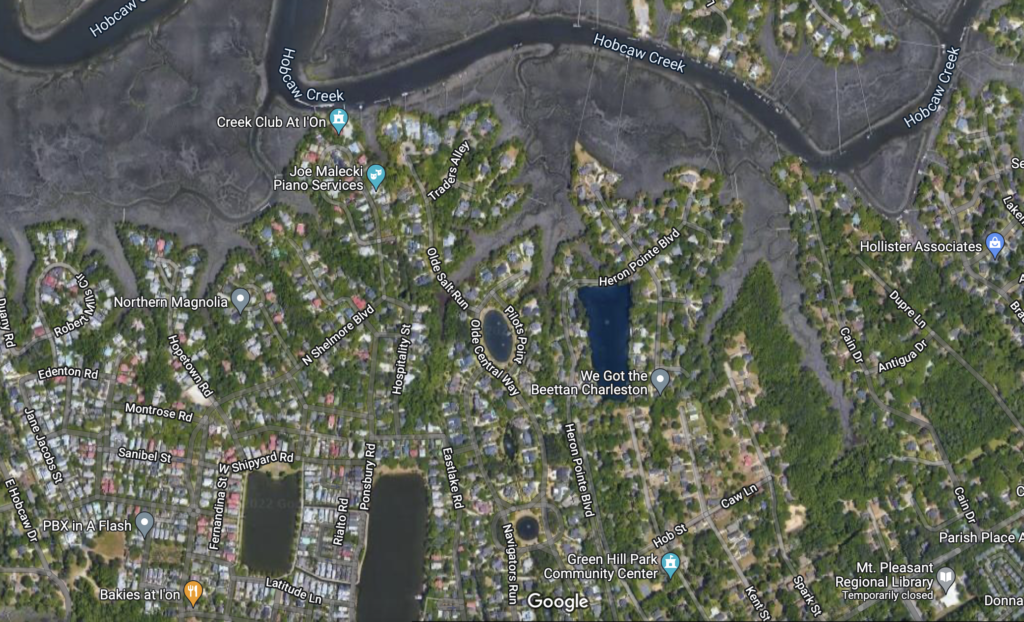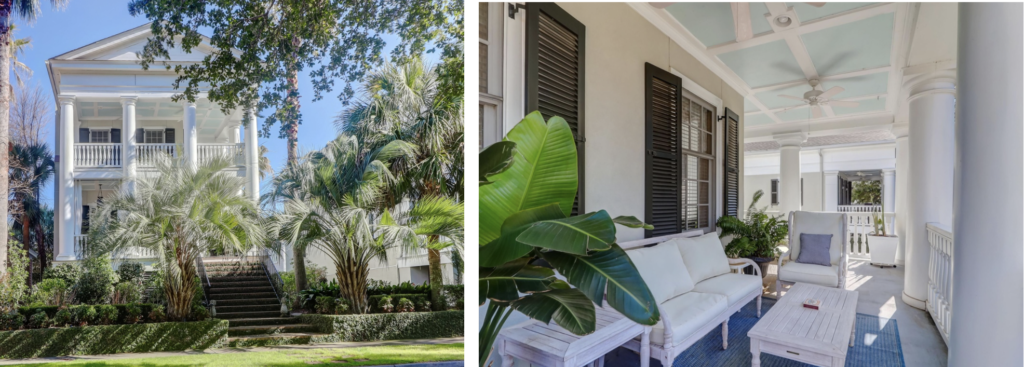Just a short drive east of Charleston over the breathtaking Ravenel Bridge near the Wando River sits I’on, the Lowcountry’s premier new urbanist community. Tucked off Mathis Ferry Road between Molasses and Hobcaw Creeks, I’on is in the heart of Mount Pleasant but seemingly a world away from the modern hustle and bustle. Its winding streets are lined with beautiful, architect-designed traditional style homes, and I’on is packed with character and amenities that make it a perfect Charleston’s new urbanist enclave.

I’on village in Mount Pleasant, a formerly rural area with a few villages that was originally known as Christ Church (one of the many Anglican parish-derived place names in the Lowcountry). Native American tribes lived near Hobcaw Point and left shell rings and “Indian mounds” before Europeans settled the area around 1680. William Watson owned Hobcaw Point, part of the plantation lands where I’on is located today. He established the first ferry running from Charleston to East Cooper in 1733.

Until the early twentieth century, the easiest way to travel from Charleston to I’on village in Mount Pleasant was by water, on ferries driven by wind power, horse power (teams operated a treadmill that drove a paddle wheel), and later, by steam or fuel engines. Andrew Hibben began another ferry service from the heart of Old Village in 1769, running to both Hobcaw Point further into Christ Church Parish and to his downtown Charleston landing at the foot of Pinckney Street.

I’on is named for Jacob Bond I’on (1782-1859), who was a Christ Church planter, local militia and U.S. military officer (serving during the War of 1812), and a state legislator. I’on was also mayor of Sullivan’s Island and a senator. He owned a Christ Church plantation called Clayfield, and he is buried in a family cemetery on the periphery of I’on community, where a historical marker commemorates his life.

I’on village in Mount Pleasant encompasses 243 acres of high land. In the 1970s, as Hobcaw subdivision grew to the north, the future site of I’on was still a series of small farm fields with a few boat landings along Shelmore and Molasses Creeks. Farmers grew soybeans and watermelons. Residents like William Hamilton III enjoyed riding his bike along the dirt roads and visiting parties and oyster roasts at Shelmore Point. As Mount Pleasant grew, “but for visionary planning, the beautiful land that became I’on would have been swallowed up by ordinary suburban sprawl, cul de sacs inhabited by strangers”, states Hamilton. “thanks to the care with which I’on was laid out and constructed making it a perfect Charleston’s new urbanist enclave, streets run along the paths of the old roads, the great trees familiar to me from childhood endure.” I’on’s acreage was six parts agricultural fields, 3 parts old growth forest, and 1 part man-made lakes.

Thanks to the tree lined streets and traditional architectural character of the community’s well-built houses and other buildings, most residents forget that I’on village in Mount Pleasant is fairly new. It was conceptualized in 1995 and the first house completed was in 1999. As a Traditional Neighborhood Development, it was planned comprehensively as a complete community, with various residential neighborhoods, outdoor recreational amenities, walkability, a balance of buildings and landscaping, and a commercial/civic corridor.

I’on village in Mount Pleasant was one of the first year-round residential new urbanist communities in the United States. Nationally renowned New Urbanist planner and architect Andres Duany of DPZ (also known for Seaside in Florida and Habersham in Beaufort South Carolina) laid out the community for visionary client Vince Graham. The firm’s website notes that each of the four neighborhoods that make up I’on have “a distinct ambiance. Rookery Lake is maintained as a sanctuary for herons’ egrets, and other wildlife. East Like has street frontage and porch-front houses on all four banks [like Colonial Lake in downtown Charleston.] West Lake hosts row houses and pedestrian promenades along its edges. Narrow canals connect the two lakes. Small greens are dispersed throughout the neighborhoods, and civic sites are located at focal points. A boat landing and open air pavilion overlook the marshes to the north.” I’on village in Mount Pleasant truly incorporates that best of Lowcountry living into a flawless Charleston’s new urbanist enclave.

I’on is designed to be pedestrian friendly and a safe, relaxing place to live. Its meandering roads have bends to help reinforce the 20 mph speed limit, and there are several walking trails wrapping around lakes, reflecting ponds, and canals. It boasts commercial space with shops and restaurants, a Montessori school, and the Inn at I’on village in Mount Pleasant, a boutique hotel that feels more like staying as a meticulously maintained historic Lowcountry house. Civitas and North Shellmore Streets are home to several restaurants (like O’Briens Pub, the Porch, Square Onion Sandwich and Pasties, and the Shellmore wine bar), and main street businesses including insurance, real estate, florists, interior design shops, spas, and a post office kiosk.

The I’on Club maintains three year-round swimming pools, three packed clay pickleball courts, six tennis courts, and a state of the arts fitness center. The I’on Trust community association hosts regular events including coffee socials, concerts, an artist’s market, and seasonal activities like easter egg hunts. East Lake soccer field, Avant Garden Park, and the nearby Hobcaw Yacht Club offer more outdoor activities. And the Creek Club at I’on village in Mount Pleasant has you covered for picturesque waterfront weddings and full-service special events.

I’on’s neotraditional architecture goes several steps further than most subdivisions in creating a picturesque Lowcountry aesthetic. Houses feature porches, piazzas, custom architectural carpentry and trim work, wide plank heart pine floors, and highest quality traditional materials inside and out. The community’s design code book ensures quality traditional design for all new builds. This Charleston’s new urbanist enclave features Charleston single houses, large central hall houses reminiscent of historic farmhouses, row houses, and cottages.


Price points start around $800,000, reflecting the high caliber of the houses in the I’on village in Mount Pleasant and the desirability of the I’on community. Lot sizes vary, from half acre to 1/20 of an acre for some of the rowhouses, offering options for families or couple or retires desiring less yard space to look after. Vince Graham notes, “There are many bright spots in the I’On story that those involved in campaigning for, building, and living in the neighborhood can view with pride. This Charleston’s new urbanist enclave continues to grow in aesthetic, economic, and social value. It attracts people from around the world interested in smart growth principles, and demonstrates that it is still possible to build in a beautiful manner.”
If you’re captivated by the charm and community spirit of I’on village in Mount Pleasant, consider making it your home. Contact Charleston Empire Properties to explore houses for sale in Charleston, SC. Our team of expert realtors is ready to help you find your perfect residence in I’On.
Link: https://charlestonempireproperties.idxbroker.com/idx/contact
Sources:
- https://ioncommunity.com/
- file:///C:/Users/butlerc/Downloads/Council%20Report%20I.pdf
- Mary-Julia Royall. Mount Pleasant: The Victorian Village. Charleston: Arcadia, 1997
- Historic maps and plats
- Nicholas Butler. “First Ferry Service Across the Cooper River.” Charleston Time Machine. https://www.ccpl.org/charleston-time-machine/first-century-ferry-service-across-cooper-river
- William J. Hamilton III. “I’on in the 1970s.” www.ioncommunity.com
- https://www.dpz.com/projects/ion/
- https://www.ionvillage.com/
- Town of Mount Pleasant Historical Commission, “Jacob Bond I’on,” Mount Pleasant Historical, accessed March 26, 2022, https://mountpleasanthistorical.org/items/show/30.
- William Hamilton. I’on at Ten: life in the new village. Mount Pleasant: self-published, 2007.
- Pam Gabriel. I’on: the making of a neo-traditional neighborhood. Mount Pleasant: self-published, 2007.
- Ralph Bailey. Cultural Resources Inventory of the I’on Development Tract. Mount Pleasant: Brockington and Associates, 1997.


